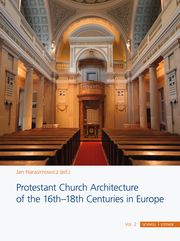Protestant Church Architecture of the 16th-18th Centuries in Europe
2400 Seiten
Lieferzeit: Vorbestellbar
Erscheint am: 11.04.2022
Harasimowiczs three volumes on Protestant Church architecture in Europe (16th-18th centuries) present the first systematic and concise analysis of Protestant places of worship throughout Europe. Starting with an introduction by the editor Jan Harasimowicz, the three volumes feature entries on 1244 churches in 41 countries. The book takes into account all the confessions that emerged after the Reformation and all the countries where it left lasting traces: from Iceland, Norway and Scotland to Romania, Slovenia and Serbia.
The two volumes, with numerous color photographs and drawings, contain the first complete study of Protestant church building in Early Modern Europe (16th-18th centuries). The variety of building materials and the abundance of spatial solutions show how great the innovative and entrepreneurial potential was that was released with the spread and stabilization of the Reformation. It broke with the autocracy of the southern and western countries, which imposed their cultural patterns on the rest of Europe. The Northern and Eastern Central European countries have since been equally involved in creating new values. Their architectural heritage, still too little known, occupies a worthy place here. Die beiden Bände, mit zahlreichen Farbaufnahmen und Zeichnungen versehen, enthalten die erste umfassende Abhandlung zum protestantischen Kirchenbau im Europa der Frühen Neuzeit (16.-18. Jh.). Die Vielfalt der eingesetzten Baumaterialien und die Fülle an räumlichen Lösungen zeigen, wie groß das innovative und unternehmerische Potential war, das mit der Verbreitung und Stabilisierung der Reformation freigesetzt wurde. Es wurde mit der Alleinherrschaft der Süd- und Westländer, die dem Rest Europas ihre Kulturmuster aufzwangen, gebrochen. Die Nord- und ostmitteleuropäische Länder waren seitdem ebenbürtig daran beteiligt, neue Werte zu schaffen. Ihr architektonisches Erbe, immer noch zu wenig bekannt, nimmt hier einen würdigen Platz ein.
| Autor | Jan Harasimowicz |
|---|---|
| Verlag | Verlag Schnell & Steiner GmbH |
| ISBN | 9783795434090 |
| ISBN/EAN | 9783795434090 |
| Lieferzeit | Vorbestellbar |
| Erscheinungsdatum | 11.04.2022 |
| Lieferbarkeitsdatum | 30.11.2024 |
| Einband | Gebunden |
| Seitenzahl | 2400 S. |
Weitere Informationen
| Verlag | Verlag Schnell & Steiner GmbH |
|---|---|
| ISBN | 9783795434090 |
| Erscheinungsdatum | 11.04.2022 |
| Einband | Gebunden |
Harasimowiczs three volumes on Protestant Church architecture in Europe (16th-18th centuries) present the first systematic and concise analysis of Protestant places of worship throughout Europe. Starting with an introduction by the editor Jan Harasimowicz, the three volumes feature entries on 1244 churches in 41 countries. The book takes into account all the confessions that emerged after the Reformation and all the countries where it left lasting traces: from Iceland, Norway and Scotland to Romania, Slovenia and Serbia.
The two volumes, with numerous color photographs and drawings, contain the first complete study of Protestant church building in Early Modern Europe (16th-18th centuries). The variety of building materials and the abundance of spatial solutions show how great the innovative and entrepreneurial potential was that was released with the spread and stabilization of the Reformation. It broke with the autocracy of the southern and western countries, which imposed their cultural patterns on the rest of Europe. The Northern and Eastern Central European countries have since been equally involved in creating new values. Their architectural heritage, still too little known, occupies a worthy place here. Die beiden Bände, mit zahlreichen Farbaufnahmen und Zeichnungen versehen, enthalten die erste umfassende Abhandlung zum protestantischen Kirchenbau im Europa der Frühen Neuzeit (16.-18. Jh.). Die Vielfalt der eingesetzten Baumaterialien und die Fülle an räumlichen Lösungen zeigen, wie groß das innovative und unternehmerische Potential war, das mit der Verbreitung und Stabilisierung der Reformation freigesetzt wurde. Es wurde mit der Alleinherrschaft der Süd- und Westländer, die dem Rest Europas ihre Kulturmuster aufzwangen, gebrochen. Die Nord- und ostmitteleuropäische Länder waren seitdem ebenbürtig daran beteiligt, neue Werte zu schaffen. Ihr architektonisches Erbe, immer noch zu wenig bekannt, nimmt hier einen würdigen Platz ein.
Kategorie

